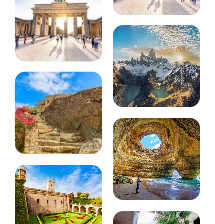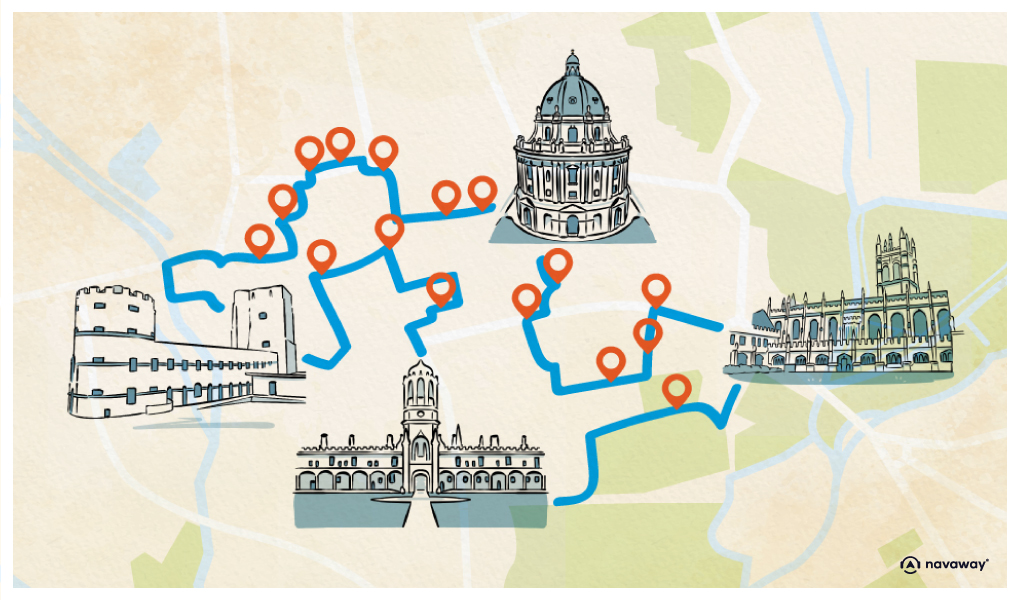
Visit Cambridge University in England
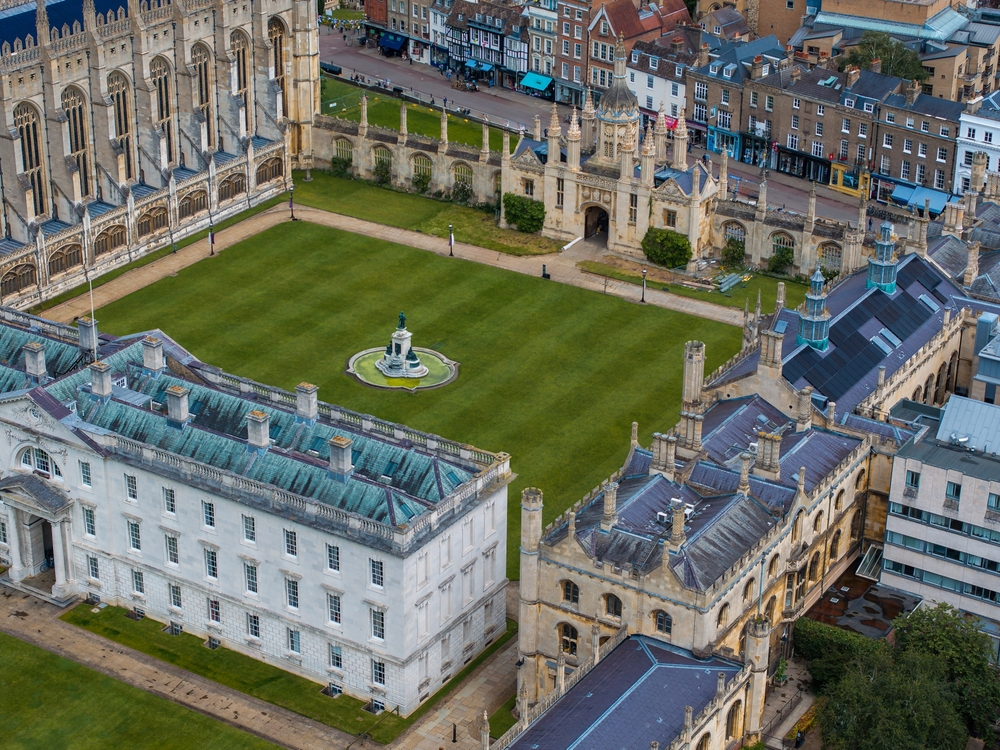
Founded in 1209, Cambridge University is one of the oldest and most prestigious academic institutions in the world. Nestling in the heart of a charming British town just 80 kilometres north of London, it attracts thousands of visitors every year to admire its centuries-old colleges, Gothic chapels and verdant gardens. Combining majestic medieval architecture with centuries-old traditions, a visit to Cambridge University is a unique experience that immerses you in eight centuries of intellectual history. From the illustrious Trinity College and King’s College to the romantic punting on the River Cam, from the exceptional museums to the historic libraries, this university city reveals its exceptional heritage around every corner. Whether you’re a history buff, an admirer of Gothic architecture or simply curious to discover the unique atmosphere of this legendary city, Cambridge promises you an unforgettable visit along its cobbled streets and majestic courtyards.

Also read about the England guide:
- Discover the 15 must-see places to visit in England
- Visit Oxford in 1 day: 26 things to do and see on foot
- Visiting London: The royal visit
- Visit Liverpool: The world in one city
- How do I get to England by ferry from France?
- Top 11 culinary specialities in London
- What are the best hotels in Oxford?
1. King’s College and its Gothic chapel
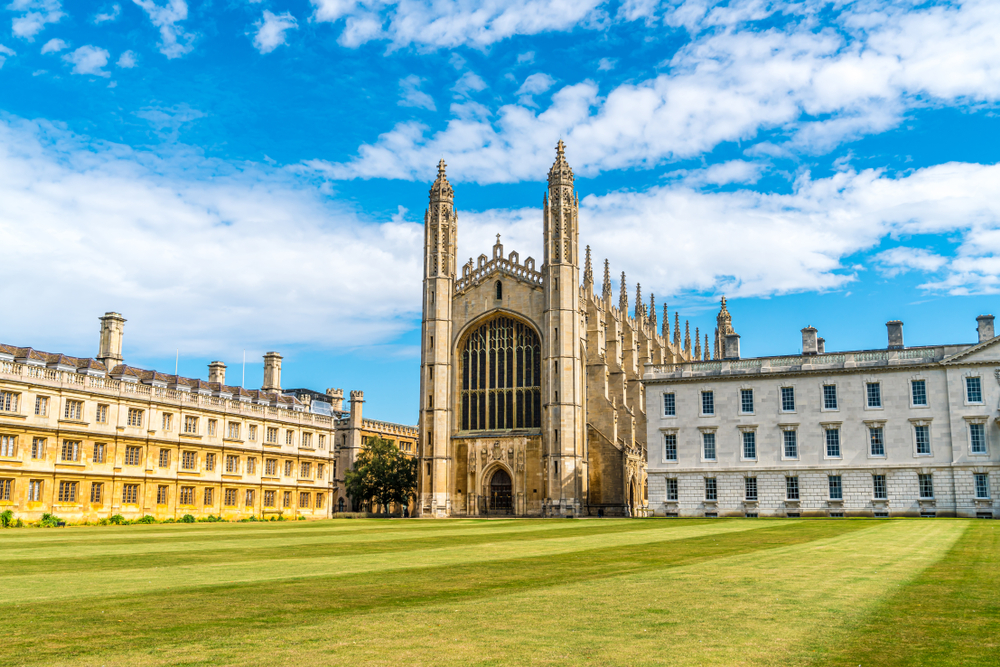
It’s impossible to visit Cambridge University without starting at King’s College, an architectural gem founded in 1441 by King Henry VI. Its perpendicular Gothic chapel, completed in 1544 after almost a century of work, is unanimously considered to be one of the most beautiful medieval buildings in England. As you pass through its doors, you will immediately be struck by the majesty of its fan vault, a masterpiece of architectural virtuosity that seems to defy the laws of gravity.
The immense 16th-century stained glass windows flood the interior with coloured light, depicting biblical scenes in exceptional detail. Rubens’ Renaissance altarpiece, “The Adoration of the Magi”, adds an incomparable artistic touch to this Gothic sanctuary. Every Christmas, the chapel hosts the famous Festival of Nine Lessons and Carols, broadcast around the world since 1928. The college’s gardens, which stretch down to the River Cam, provide a bucolic setting for a stroll after your visit.
Practical information: King’s College (King’s Parade, Cambridge CB2 1ST, rated 4.7/5 on Google out of 18,000 reviews). Adult price: £11, concessions: £8.50. Times vary according to the season, so check before you visit as the college may close for academic events.
2. Trinity College and the Wren Library
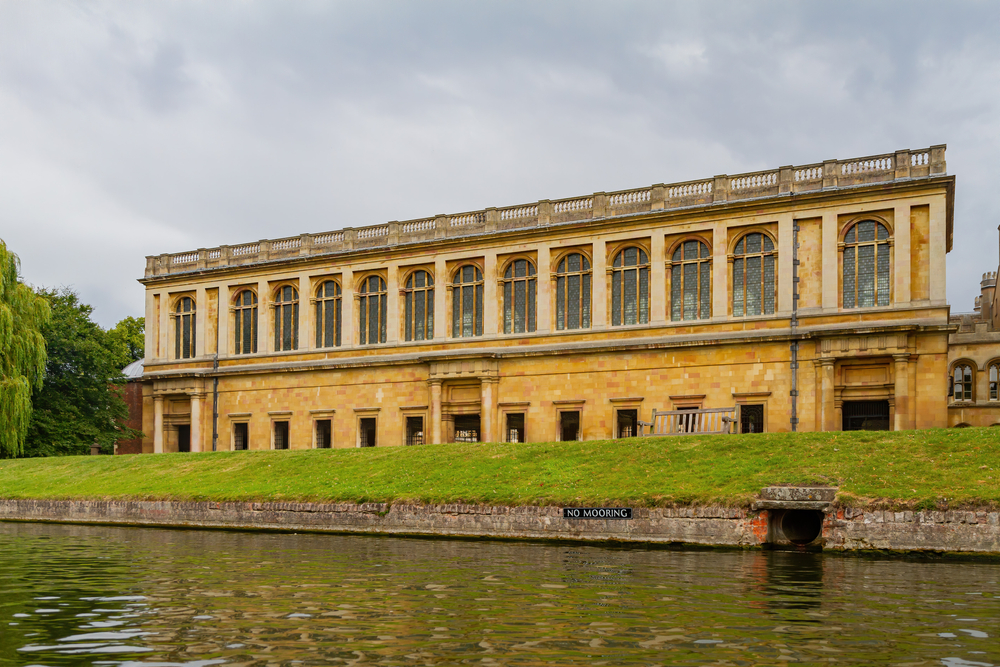
Founded in 1546 by King Henry VIII, Trinity College is Cambridge’s largest and richest college. Crossing its monumental Great Gate transports you into a world of academic grandeur. The Great Court, a vast sixteenth-century courtyard, is the largest university courtyard in the world and was the setting for the famous opening scene of the film “Chariots of Fire”. This majestic courtyard, lined with historic buildings, exudes a solemn atmosphere conducive to reflection.
The Wren Library, designed in 1695 by the famous architect Christopher Wren, is the jewel in the college’s crown. This baroque library houses priceless treasures, including original manuscripts by Isaac Newton, one of Trinity’s most illustrious students. Other famous alumni include Lord Byron, the philosopher Bertrand Russell, and the quantum physicist Niels Bohr. The library also holds autograph letters from William Shakespeare and rare books that testify to the institution’s exceptional intellectual legacy.
Practical information: Trinity College (Trinity St, Cambridge CB2 1TQ, rated 4.6/5 on Google out of 7,500 reviews). Fees vary, generally around £5 for access to courses. The Wren Library is free on certain days.
3. St John’s College and the Bridge of Sighs
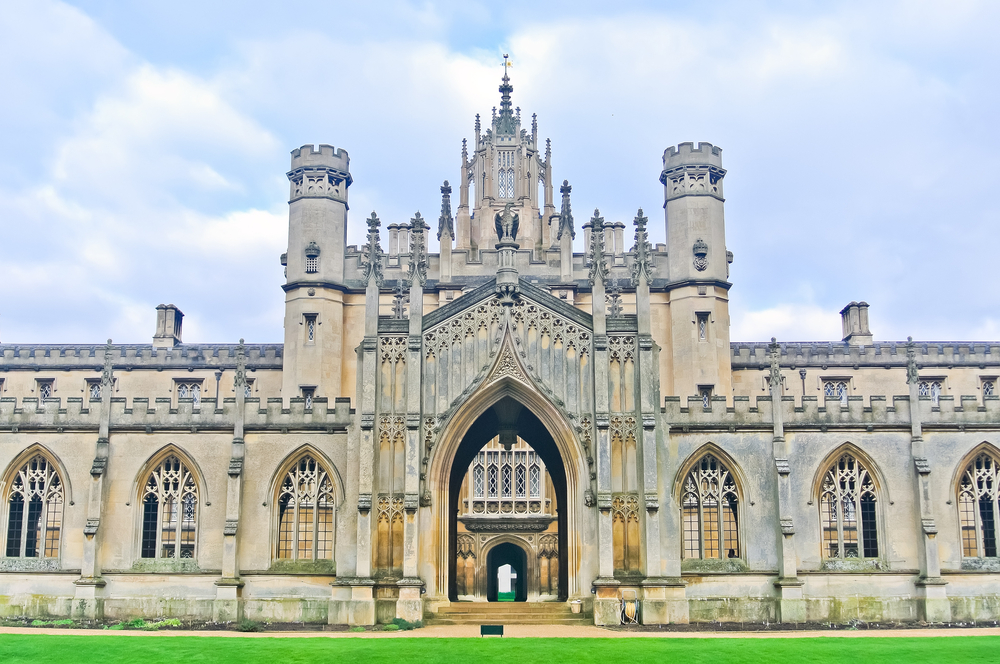
Established in 1511, St John’s College has a rich architectural heritage that spans the centuries. As you explore its different courtyards, you will discover a fascinating journey through the history of British architecture, from the Tudor to the Neo-Gothic. The College’s alumni include many Nobel Prize winners and illustrious figures who have left their mark on British history.
The famous Bridge of Sighs, built in 1831, is undoubtedly Cambridge’s most photographed landmark. This covered passageway, decorated with Gothic windows, links two of the college’s buildings over the River Cam. Contrary to legend, the bridge has no connection with Isaac Newton, but its name was given by Queen Victoria when she visited in 1847, struck by its resemblance to the Venetian bridge of the same name. The view from the river on a punting trip offers a romantic perspective on this iconic bridge. The college chapel, with its Victorian stained glass windows, and the magnificent entrance portal are also well worth a visit.
Practical information: St John’s College (St John’s Street, Cambridge CB2 1TP). Adult admission: around £10. Times: usually 10am-3.30pm, but may vary.
4. Queens’ College and the Mathematics Bridge
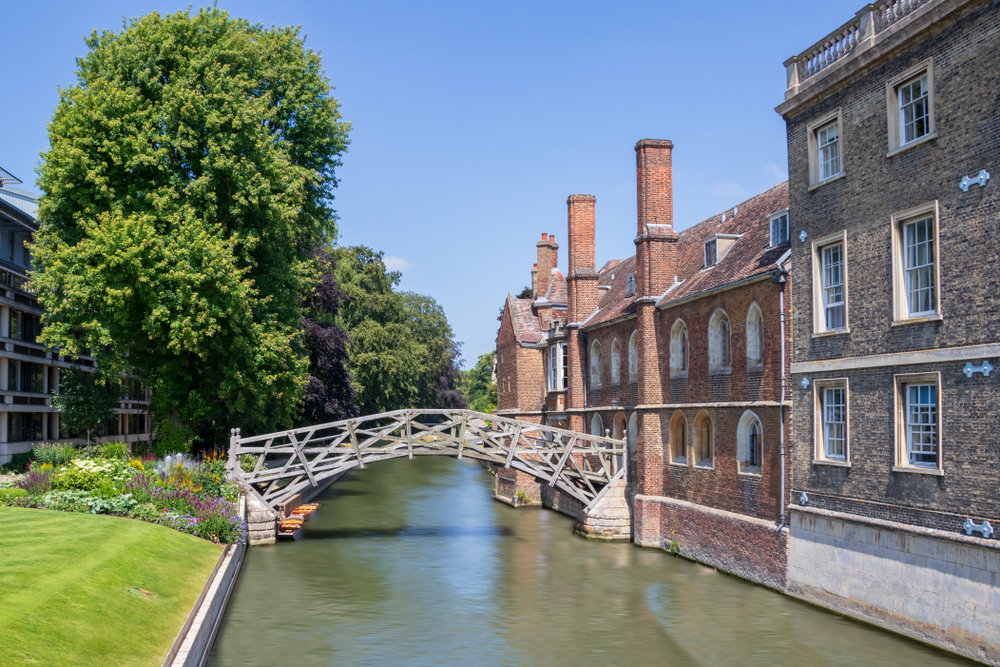
Founded in 1448 by Marguerite d’Anjou and refounded in 1465 by Elizabeth Woodville, Queens’ College (note the apostrophe after the ‘s’, symbolising the two queens) offers a magnificent panorama of architectural evolution in Cambridge. Its buildings harmoniously blend medieval, Tudor and Baroque styles, creating an ensemble of rare aesthetic coherence. The medieval courtyard, with its distinctive red half-timbering, is one of the most picturesque in Cambridge.
The Mathematical Bridge, built in wood in 1749, fascinates with its ingenious design. Legend has it that Isaac Newton drew up the plans without using nails or bolts, and that students took it apart and then clumsily reassembled it by adding metal fixings. Newton died in 1727, 22 years before the bridge was built. Nevertheless, this tangential arch bridge remains a fascinating feat of engineering. The chapel and gardens bordering the Cam are a pleasant complement to a visit to this peaceful college.
Practical information: Queens’ College (Silver Street, Cambridge CB3 9ET, rated 4.6/5 on Google out of 3,200 reviews). Adult price: around £5.
5. The Fitzwilliam Museum

Opened in 1848, the Fitzwilliam Museum is Cambridge University’s main museum of art and antiquities. Located on Trumpington Street, this majestic neoclassical building designed by the architect George Basevi houses collections of exceptional richness. Free admission allows everyone to discover this cultural treasure trove, which rivals the greatest British museums.
The museum’s galleries contain works by European masters such as Monet, Picasso, Rubens, Titian and Rembrandt. The collection of Egyptian antiquities, illuminated manuscripts, Asian ceramics and objects of decorative art impresses with its diversity and quality. The rooms devoted to British applied art, with their porcelain, silverware and period furniture, bear witness to British artistic refinement through the centuries. The museum regularly organises top-quality temporary exhibitions that further enhance the visit.
Practical information: Fitzwilliam Museum (Trumpington Street, Cambridge CB2 1RB, rated 4.7/5 on Google out of 12,000 reviews). Free admission. Opening times: Tuesday-Saturday 10am-5pm, Sunday 12pm-5pm, closed on Mondays.
6. Punting on the river Cam
Download the audio-guided tour to discover Oxford on foot and on your own
Although Cambridge does not yet have a Navaway audio tour, its neighbour and rival Oxford offers a complete itinerary for discovering Britain’s other great university city. Featuring 26 points of interest with commentary, this route allows you to explore Oxford on your own, from historic colleges to iconic monuments, while learning fascinating anecdotes about this legendary city.
Punting on the River Cam is the quintessential Cambridge experience. These flat-bottomed boats, propelled by a long pole pushed against the riverbed, offer a unique view of the backs, the lush gardens that stretch behind the main colleges. This tradition dates back to the 19th century and remains a popular pastime for students and visitors from all over the world.
Along the way, you’ll glide under the mathematical bridge at Queens’ College, past the majestic facades of King’s College, Trinity College, St John’s College and Clare College. The Bridge of Sighs is at its most photogenic from the river. You can choose to hire your own punt and try your hand at the delicate art of steering (which is harder than it looks!), or opt for a guided tour with an experienced ‘driver’ who will tell you all about the history of the area while skilfully manoeuvring the pole. This 45-minute ride is an unforgettable moment of relaxation and offers exceptional photographic opportunities.
Practical information: Several companies offer hire and guided tours from Silver Street or Magdalene Bridge. Prices: around £30-35 per hour for hire, £15-20 per person for a shared guided tour.
7. Senate House
Built between 1722 and 1730 to designs by architect James Gibbs, Senate House is the ceremonial heart of Cambridge University. Every year, this elegant neoclassical building hosts the University’s graduation ceremonies, perpetuating age-old traditions in a sumptuous setting. Its imposing white façade and harmonious proportions make it one of the finest examples of Palladian architecture in Cambridge.
The interior, although rarely open to the public outside official ceremonies, bears witness to the grandeur of the institution with its carved woodwork and stained glass windows. Located close to Gonville and Caius College and Great St Mary’s Church, Senate House fits perfectly into the historic urban fabric of central Cambridge. The surrounding lawn, Senate House Lawn, is a favourite gathering place for students during examinations and academic events. Even from the outside, Senate House impresses with its majesty and reminds visitors of the prestige and academic tradition that has characterised Cambridge for eight centuries.
Practical information: Senate House (Senate House Passage, Cambridge CB2 1TN). Generally closed to the public except for special events. External view freely accessible.
8. Cambridge University Botanic Garden
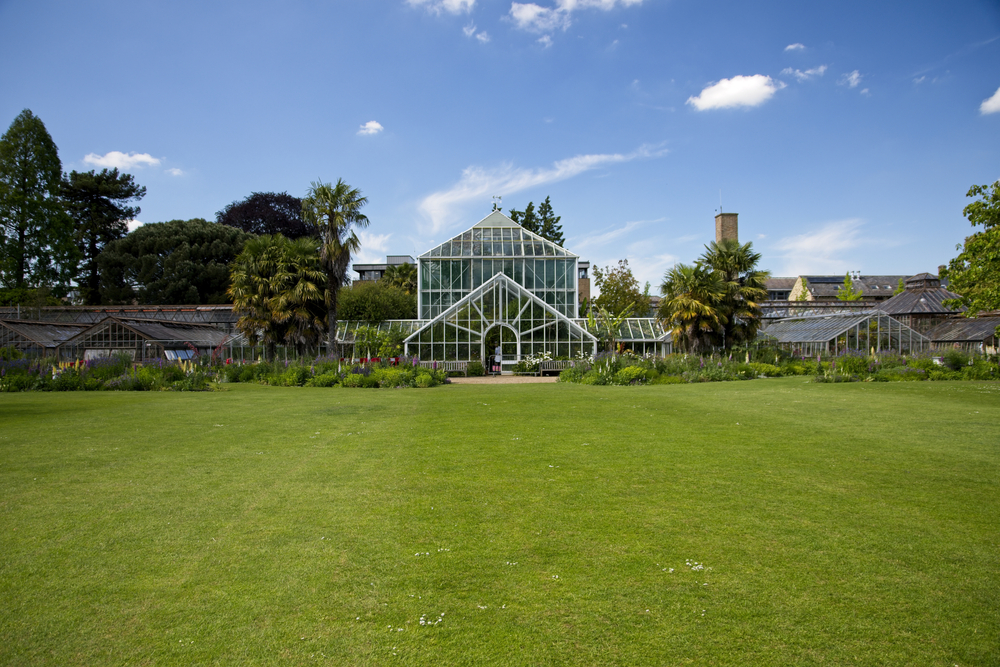
Inaugurated in 1846, the Cambridge University Botanic Garden covers 16 hectares just a few minutes’ walk from the city centre. This internationally-renowned botanic garden brings together over 8,000 plant species from all over the world, providing a space for relaxation, wonder and scientific research. The themed collections allow visitors to travel across climates and continents without leaving Cambridge.
The Victorian greenhouses house lush tropical plants, desert cacti and rare orchids in carefully controlled atmospheres. The outdoor gardens feature species organised by botanical family, use (medicinal and aromatic plants) or geographical origin. The rock garden, the fragrant winter garden and the arboretum with its century-old trees offer soothing walks in all seasons. Themed guided tours and educational workshops are regularly organised for botany enthusiasts. Located close to the station, this haven of greenery is an ideal refreshing stopover for nature lovers after exploring the stone colleges.
Practical info: Cambridge University Botanic Garden (1 Brookside, Cambridge CB2 1JE, rated 4.7/5 on Google out of 9,500 reviews). Adult price: around £7-8. Times: 10am-6pm in summer, 10am-4pm in winter.
9. The Round Church
Built around 1130, the Round Church (officially the Church of the Holy Sepulchre) is one of only four surviving medieval circular churches in England. Its unique Norman architecture, inspired by the Church of the Holy Sepulchre in Jerusalem, bears witness to the influence of the Crusades on European religious architecture. The central rotunda, supported by eight massive pillars, creates a harmonious and unusual interior space.
A rectangular chancel was added in the fifteenth century to enlarge the building and meet the needs of a growing congregation. Today, the church houses a fascinating information centre on the religious history of Cambridge and the spiritual and intellectual development of the university city. Exhibitions trace a thousand years of Christianity in Cambridge, from the earliest Saxon churches to the present day. Located in the heart of the city, between Bridge Street and Sidney Street, the Round Church is a precious witness to Cambridge’s medieval past, reminding us that the city existed long before the founding of its university.
Practical information: Round Church (Bridge Street, Cambridge CB2 1UB, rated 4.5/5 on Google out of 1,200 reviews). Admission charge (around £3-4) including access to the exhibition.
10. Cambridge University Library
Founded in 1424, Cambridge University Library is one of the oldest and most prestigious university libraries in the world. It now holds over eight million items, including precious medieval manuscripts, incunabula (books printed before 1500), historical scientific archives and modern collections in all fields of knowledge. As a legal deposit library, it automatically receives one copy of every book published in the UK.
The current building, erected in 1934, boasts an imposing 48-metre-high storage tower that dominates the Cambridge landscape. Its 1930s functionalist architecture contrasts with the gothic buildings of the colleges, but bears witness to the university’s ongoing modernisation. Researchers from all over the world come to consult the library’s exceptional holdings, which include manuscripts by Charles Darwin, Isaac Newton and many other scientists who have left their mark on the history of science. Temporary exhibitions allow the general public to discover some of the treasures usually reserved for accredited researchers.
Practical information: Cambridge University Library (West Road, Cambridge CB3 9DR). Access restricted to members of the University for consultation, but temporary exhibitions open to the public.
How do I get to Cambridge?
Cambridge is around 80 kilometres north of London, making it the perfect day trip from the British capital. The train remains the quickest and most convenient way to reach Cambridge. Direct trains depart regularly from London King’s Cross and take around 50 minutes to 1 hour to reach Cambridge station. Tickets generally cost between £15 and £30, depending on the time of day and whether you book in advance.
From Stansted airport, just 45 kilometres away, you can take a direct train (about 30 minutes) or a National Express bus (about 50 minutes). If you are arriving from other London airports such as Heathrow or Gatwick, take the train first to King’s Cross and then change for Cambridge. By car, Cambridge is accessible from London via the M11 motorway, but parking in the city centre is limited and expensive. It is advisable to use the Park & Ride car parks on the outskirts of the city, which offer a regular shuttle service to the centre at a favourable rate. Once here, Cambridge is best explored on foot or by bike, as the city is very compact and largely pedestrianised in its historic centre.
When is the best time to visit Cambridge?
The best time to visit Cambridge is from May to September, when the weather is mildest and the days longest. Spring (April-May) offers the enchanting spectacle of the college gardens in bloom, with cherry trees and magnolias colouring the historic courtyards. Summer (June-August) has the most pleasant temperatures, ideal for punting on the Cam, but it’s also the peak tourist season, with a huge influx of visitors.
Autumn (September-October) is also an excellent time of year, with fewer tourists, still mild temperatures and the magnificent autumn colours that adorn the parks and gardens. It’s also the start of the university year, when the student atmosphere is in full swing. Winter (November-March) is quieter and less expensive, but some colleges may have reduced opening hours, and the weather can be cold and wet. However, visiting Cambridge in the snow or during the Christmas lights offers a magical atmosphere. Note that during exam periods (May-June) and university holidays, some colleges may close to visitors or have limited access.
How long will it take to visit Cambridge?
For a first discovery of Cambridge, a full day allows you to visit the main colleges (King’s College, Trinity College, St John’s College), do some punting on the Cam and stroll around the historic centre. If you want to explore several colleges in greater depth, visit museums such as the Fitzwilliam Museum, relax in the Botanic Garden and take full advantage of the city’s unique atmosphere, allow two days. This will also allow you to discover Cambridge at a more leisurely pace, have lunch in a traditional pub and perhaps attend a concert in one of the college chapels. For those with a passion for academic history or architecture, three days is not too much time to explore all the colleges, museums and historic sites without rushing. Don’t forget that Cambridge lends itself wonderfully to strolling: taking the time to sit in a café, watch the ballet of cyclists or read in a park is an integral part of the Cantabrian experience.
In conclusion, a visit to Cambridge University is much more than a simple tourist excursion: it’s an immersion in eight centuries of academic excellence, scientific innovation and preserved traditions. From majestic Gothic chapels to libraries brimming with literary treasures, from peaceful medieval courtyards to the romantic banks of the River Cam, every corner of this legendary university city tells a fascinating story. Whether you’re captivated by the architecture, a history buff, an art lover or simply curious to discover the unique atmosphere that has given birth to so many geniuses, Cambridge will win you over with its timeless charm. Taking the time to wander its cobbled streets, admire its centuries-old colleges and try your hand at punting on the river will leave you with lasting memories. To complete your discovery of Britain’s great university cities, don’t hesitate to also explore Oxford, Cambridge’s eternal rival, thanks to the Navaway audio tour, which will allow you to discover its 26 places of interest on your own.
Frequently asked questions
Can you visit Cambridge colleges for free?
Most colleges in Cambridge charge visitors, with fees generally ranging from £5 to £11 per college. King’s College is the most expensive (£11), while others such as Queens’ College and Trinity College are less expensive (around £5). Some colleges remain free or ask for a voluntary contribution. Times and prices may vary according to the season and academic events. It is advisable to check the latest information on the official websites before your visit. Some libraries, such as Trinity College’s Wren Library, are free at certain times.
What is the difference between Oxford and Cambridge?
Oxford and Cambridge are the two oldest and most prestigious British universities, often referred to together as Oxbridge. Oxford, founded in the 12th century, is slightly older than Cambridge (1209). Oxford has a more urban and cosmopolitan feel, with a larger city, while Cambridge offers a more intimate and bucolic setting with its punting river Cam. Architecturally, Oxford favours the Gothic and Baroque styles, while Cambridge has more Renaissance and neoclassical architecture. Both rival each other for academic excellence, but Oxford has historically been more associated with the humanities and politics, while Cambridge excels particularly in science and mathematics. The rivalry between the two universities, particularly in the annual sporting competitions, is an integral part of their identity.
Do I need to book tickets in advance to visit Cambridge?
For King’s College, online booking is strongly recommended, especially during the high season (April-September) and at weekends, as the number of daily visitors is limited. Other colleges generally accept visitors without booking, but may close for academic events, examinations or ceremonies. For punting, you can book in advance to guarantee a place at the most popular times, although on-site hire is often available. Museums such as the Fitzwilliam Museum are free and do not require booking. If you are planning to visit several colleges, arrive early in the morning to avoid the crowds of tourist groups who usually arrive around 11am.
Are the Cambridge colleges accessible to people with reduced mobility?
Accessibility varies considerably from one college to another due to the age of the buildings. Medieval structures often present obstacles such as narrow staircases, uneven paving and low doorways. King’s College and Trinity College have improved accessibility with ramps and lifts in some areas, but full access remains limited. The Fitzwilliam Museum has wheelchair access and lifts. The Cambridge Botanic Garden has adapted tarmac paths. It is advisable to contact the colleges directly before your visit to find out about special facilities. Cambridge city centre, largely pedestrianised with cobbled streets, can present mobility challenges, but more accessible alternative routes exist.
200 audioguided tours for cities all around the world
Download